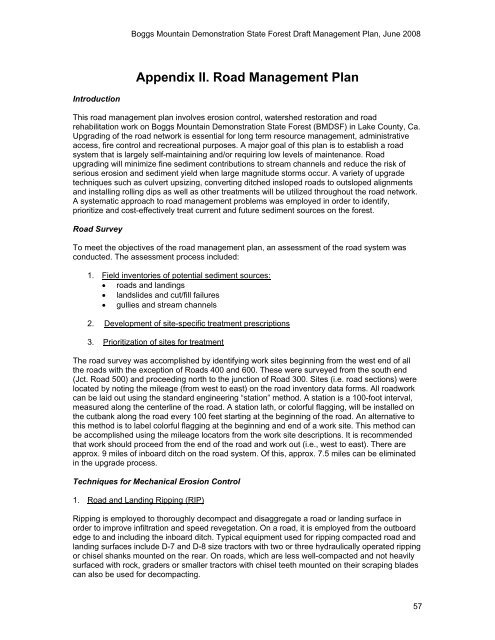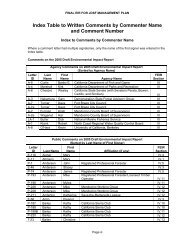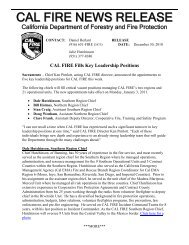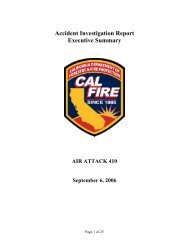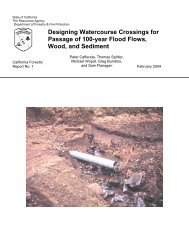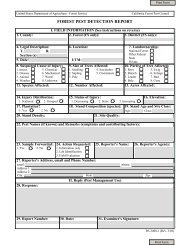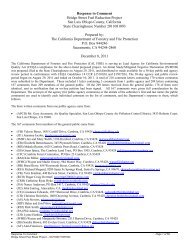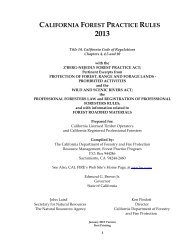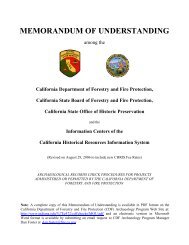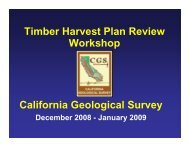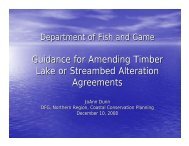Boggs Mountain Demonstration State Forest Draft ... - Cal Fire
Boggs Mountain Demonstration State Forest Draft ... - Cal Fire
Boggs Mountain Demonstration State Forest Draft ... - Cal Fire
You also want an ePaper? Increase the reach of your titles
YUMPU automatically turns print PDFs into web optimized ePapers that Google loves.
<strong>Boggs</strong> <strong>Mountain</strong> <strong>Demonstration</strong> <strong>State</strong> <strong>Forest</strong> <strong>Draft</strong> Management Plan, June 2008<br />
Appendix II. Road Management Plan<br />
Introduction<br />
This road management plan involves erosion control, watershed restoration and road<br />
rehabilitation work on <strong>Boggs</strong> <strong>Mountain</strong> <strong>Demonstration</strong> <strong>State</strong> <strong>Forest</strong> (BMDSF) in Lake County, Ca.<br />
Upgrading of the road network is essential for long term resource management, administrative<br />
access, fire control and recreational purposes. A major goal of this plan is to establish a road<br />
system that is largely self-maintaining and/or requiring low levels of maintenance. Road<br />
upgrading will minimize fine sediment contributions to stream channels and reduce the risk of<br />
serious erosion and sediment yield when large magnitude storms occur. A variety of upgrade<br />
techniques such as culvert upsizing, converting ditched insloped roads to outsloped alignments<br />
and installing rolling dips as well as other treatments will be utilized throughout the road network.<br />
A systematic approach to road management problems was employed in order to identify,<br />
prioritize and cost-effectively treat current and future sediment sources on the forest.<br />
Road Survey<br />
To meet the objectives of the road management plan, an assessment of the road system was<br />
conducted. The assessment process included:<br />
1. Field inventories of potential sediment sources:<br />
• roads and landings<br />
• landslides and cut/fill failures<br />
• gullies and stream channels<br />
2. Development of site-specific treatment prescriptions<br />
3. Prioritization of sites for treatment<br />
The road survey was accomplished by identifying work sites beginning from the west end of all<br />
the roads with the exception of Roads 400 and 600. These were surveyed from the south end<br />
(Jct. Road 500) and proceeding north to the junction of Road 300. Sites (i.e. road sections) were<br />
located by noting the mileage (from west to east) on the road inventory data forms. All roadwork<br />
can be laid out using the standard engineering “station” method. A station is a 100-foot interval,<br />
measured along the centerline of the road. A station lath, or colorful flagging, will be installed on<br />
the cutbank along the road every 100 feet starting at the beginning of the road. An alternative to<br />
this method is to label colorful flagging at the beginning and end of a work site. This method can<br />
be accomplished using the mileage locators from the work site descriptions. It is recommended<br />
that work should proceed from the end of the road and work out (i.e., west to east). There are<br />
approx. 9 miles of inboard ditch on the road system. Of this, approx. 7.5 miles can be eliminated<br />
in the upgrade process.<br />
Techniques for Mechanical Erosion Control<br />
1. Road and Landing Ripping (RIP)<br />
Ripping is employed to thoroughly decompact and disaggregate a road or landing surface in<br />
order to improve infiltration and speed revegetation. On a road, it is employed from the outboard<br />
edge to and including the inboard ditch. Typical equipment used for ripping compacted road and<br />
landing surfaces include D-7 and D-8 size tractors with two or three hydraulically operated ripping<br />
or chisel shanks mounted on the rear. On roads, which are less well-compacted and not heavily<br />
surfaced with rock, graders or smaller tractors with chisel teeth mounted on their scraping blades<br />
can also be used for decompacting.<br />
57


